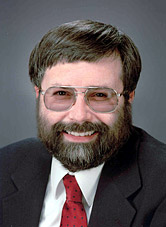The Pennsylvania primary looms large in the tight contest for the Democratic nomination. In an interview with Pew Forum Associate Director Mark O’Keefe, Senior Fellow John Green explains why the connections that Hillary Clinton and Barack Obama make – or fail to make – with the state’s religious voters could have major consequences on April 22. While John McCain has clinched the Republican nomination, the Keystone State’s religious voters could play an important role for him in the Nov. 4 general election.
Featuring: John Green, Senior Fellow in Religion and American Politics, Pew Forum on Religion & Public Life
Interviewer: Mark O’Keefe, Associate Director, Web Publishing, Pew Forum on Religion & Public Life
In this Q&A: Religious diversity in Pennsylvania The Catholic factor Reaching out to the religious Looking forward to November

All eyes are focused on the next Democratic presidential primary, which will be held in Pennsylvania on April 22. What role are religious groups likely to play in that contest?
Religious groups could be quite important. Like many large battleground states, Pennsylvania is religiously diverse. According to the Pew Forum’s U.S. Religious Landscape Survey, Catholics are the largest religious community, making up 29% of Pennsylvania’s adult population, followed by mainline Protestants at 25% and evangelical Protestants at 18%. The remaining 28% belong to groups other than the three largest Christian communities.
The key question, of course, is: How many members of these groups will vote in the Democratic primary? The Keystone State was not a factor in the 2000 and 2004 presidential nominating contests, so we don’t have a good historical baseline for 2008. The next best thing is the most recent general election. While the turnout on April 22 will likely not be as high as in the close 2004 presidential race, it will likely look more like a general election than the typical primary because of the tight competition between Hillary Clinton and Barack Obama. So the 2004 results are useful. In 2004, the Pennsylvania exit poll revealed that Catholics made up 35% of self-identified Democratic voters, with white Catholics at 30%. White Protestants, both mainline and evangelical, accounted for about 29% of Democrats, with black Protestants at 15% and the religiously unaffiliated at less than 10%.
So are white Catholics the key to the Keystone State?
White Catholics are certainly receiving a lot of attention. This is partly because of their size and prominence among Pennsylvania Democrats but also because of the dynamics of the campaign. White Catholics have been a pillar of Clinton’s voter coalition in her big-state victories to date. For example, in the Ohio primary, she received 65% of the white Catholic vote en route to a 10-percentage-point victory overall over Obama. The current state polls suggest that Clinton enjoys a huge lead among white Catholics, and that is likely one of the reasons she has been consistently ahead.
Obama will certainly want to improve his following among white Catholics. He is trying to expand his support among younger and more affluent Catholics, who have backed him in other states, to include older and blue-collar Catholics who have tended to support Clinton. Something like this happened in two large, industrial states where Obama won. In Missouri, Clinton had a small 50%-to-46% advantage among white Catholics, and in Wisconsin Obama edged Clinton 50% to 49% with this group.
Obama can likely count on other important religious constituencies in Pennsylvania, particularly black Protestants and religiously unaffiliated voters, two groups that strongly backed him in previous states. But these religious groups are not likely to be a large enough part of the Pennsylvania vote for him to prevail with their votes alone.
White Protestants, both mainline and evangelical, could be important as well. Mainline Protestants may matter most in the suburbs surrounding Philadelphia. Indeed, some scholars believe that the term “mainline” originated in the suburban communities along the “main line” of the Pennsylvania railroad and then was eventually applied to the prestigious Protestant churches in those communities. Evangelical Protestants may matter most in the central and western parts of the state, and, like Ohio, a fair number of evangelicals may vote in the Democratic primary. And non-Christian groups, such as Jews and Muslims, could be important in the metropolitan areas of the state if the contest gets close. Current polls suggest that Clinton may be leading among all these religious groups – Protestants and non-Christians alike.
How are the candidates targeting various religious groups in Pennsylvania?
Not surprisingly, a fierce battle is being fought over the Catholic vote. One aspect of this campaign is a “battle of endorsements.” Obama has the active support of some prominent Catholic Democrats, including Sen. Ted Kennedy and his wife, Vikki Kennedy. Clinton has been able to counter with her own Kennedys – Kathleen Kennedy Townsend and Robert F. Kennedy Jr. Obama received the endorsement of Pennsylvania’s junior senator, Bob Casey, a Catholic who is the son a popular former governor. This endorsement may offset the solid support Clinton has among the Democratic leadership in the state, including the governor and the Philadelphia mayor.
There has also been extensive campaign activity. Obama and his prominent supporters have held listening sessions with Catholic groups as well as holding community faith forums, some of which target Catholics. Such events have been complemented with phone banking and direct mail aimed at Catholics, including a letter Obama sent to thousands of nuns earlier in the campaign. At her campaign events, Clinton has played up her ties to the state, including the fact that she was born in the industrial city of Scranton, Pa., a Catholic stronghold. She and Bill Clinton have campaigned at Catholic events, such as St. Patrick’s Day parades. The campaign has pursued Catholic voters via mail, email, and door-to-door canvassing.
The campaign efforts have been matched by extensive interest in the campaign by Catholic organizations. There are reports of high attendance at parish meetings concerning the U.S. Conference of Catholic Bishops’ guide on issues, “Faithful Citizenship,” as well as extensive activity by Catholic interest groups, such as Catholics in Alliance for the Common Good, which is organizing issue forums in the state.
Although outreach to other religious groups has not received as much attention, there is reason to believe that similar campaign activities are directed at them as well. It was likely not entirely coincidental that Obama choose Philadelphia as the venue for his speech on religion and race in response to the controversy surrounding his former pastor, the Rev. Jeremiah Wright.
Are there other factors that might influence the primary results?
Events beyond the campaigns could make a big difference. For example, the pope’s visit to Washington, D.C., and New York could have an indirect influence on Pennsylvania Catholics. A lot will depend on the particular issues that the pope chooses to emphasize.
One event that could have a direct bearing on the primary is the Compassion Forum scheduled for April 13 at Messiah College, an evangelical college near Harrisburg, Pa., the state capital. This event is supported by a wide spectrum of religious leaders and is likely to get extensive coverage in the Keystone State, especially within religious circles. Indeed, the Church Communication Network is planning to broadcast the forum to 1,000 churches on April 20, two days before the primary. So far, Sens. Clinton and Obama have agreed to attend the forum. Sen. McCain has not yet agreed to participate.
Is McCain’s absence from the Compassion Forum likely to hurt him in Pennsylvania?
Since the GOP nomination race is over, the Compassion Forum is unlikely to have an immediate impact on McCain’s standing. But it could have an impact in the general election. In 2000 and 2004, Pennsylvania was on everyone’s list of battleground states, with the Democrats wining both times by small margins. It is likely to be very competitive in 2008 as well. McCain will need to expand upon the Bush coalition in order to gain Pennsylvania’s 21 electoral votes. This could involve replicating as much as possible Bush’s appeal to conservative white Catholics and Protestants but also attracting more moderate and independent religious voters. The Compassion Forum could present McCain with an opportunity to reach both types of voters and it could fit in with his own “outreach tour” slated for this spring. It may be, however, that the McCain campaign has another strategy in mind.
Of course, the eventual Democratic nominee will face the same kind of strategic challenge in November. Holding together Al Gore’s and John Kerry’s Keystone State voter coalitions will not be easy in a hard-fought campaign. It could be that the connections Clinton and Obama make, or fail to make, with religious primary voters in Pennsylvania will have major consequences on November 4.
Photo Credit: AP
